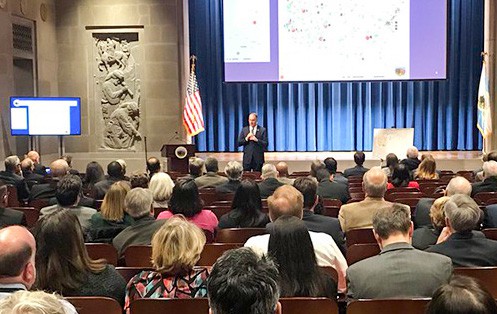Share this article
Interior unveils regional reorganization plan
Interior Secretary Ryan Zinke has moved one step closer to solidifying his plans for on-the-ground reorganization of the Department of the Interior.
These plans, outlined in a meeting last week to the department’s senior career officials, known as the Senior Executive Service, would break all Interior agencies into the same 13 administrative regions.
This would be a major departure from current regional operations. The nine agencies within Interior each currently operate separate and unique regional structures. The U.S. Fish and Wildlife Service, for example, manages its operations out of eight regional offices. The Bureau of Land Management runs 12 state-based offices.
According to an email sent by Todd Wynn, DOI’s Director of the Office of Intergovernmental and External Affairs, the goal of doing away with these disparate regional structures is to “reduce administrative redundancy, share resources more effectively, improve coordination among federal, state and local agencies, improve interagency coordination, drive more decisions to be made at the regional level rather than in Washington D.C., and facilitate joint problem-solving.”
These statements were echoed by Zinke in a video released by the department.
As has been stated since the beginning of the Trump administration, Zinke believes the best way to achieve these goals is to break up the regions based on ecosystems. In coordination with the U.S. Geological Survey, the department settled on a draft map drawn around U.S. watersheds.
“The commonalities of land management are better defined when we take an ecosystem approach,” said DOI Associate Deputy Director Jim Carson, “and what we used was watersheds because the flora and fauna within a watershed tends to be more common that across watersheds.”
These proposed regions would bisect multiple state lines, however, and could lead to push back from state agencies and other stakeholders who carry out operations based on jurisdictional boundaries.
During the two-day Senior Executive Service meeting, brainstorming sessions were reportedly held to determine any difficulties these employees may come across if the transition were to take place as proposed. These plans have yet to be solidified, and the goal of last week’s release was in part to seek comments from employees and stakeholders.
Final details of the reorganization plan are expected to be released in the administration’s fiscal year 2019 budget request due out next month. These plans may include other ideas floated by Interior last week, such as having one common regional director sit at the helm of each of the 13 regions, and organizing staff based on job function rather than bureau.
After the budget is released, Zinke will then face the challenge of selling these plans to Congress.
Header Image: A map of the new common regional boundaries proposed by DOI.









